Drought-tolerant plants are a fantastic choice for creating a water-wise garden in dry climates or areas with water restrictions. Not only are these plants resilient, but they also add beauty to your landscape. If you’re in California, where drought-tolerant landscaping is gaining popularity, there are plenty of options to consider. By selecting the right drought-tolerant plants, you can create a garden that requires less maintenance and resources.
Key Takeaways:
- Drought-tolerant plants conserve water in your garden
- They thrive in dry climates or areas with water restrictions
- Drought-tolerant plants reduce maintenance and resource requirements
- California offers a wide range of drought-tolerant options
- Creating a water-wise garden can be both beautiful and sustainable
Benefits of Drought-Tolerant Landscaping
Drought-tolerant landscaping offers numerous benefits beyond water conservation. When designing your outdoor space in Southern California, implementing a drought-tolerant front yard or a drought-tolerant landscape throughout your property can be highly advantageous. Not only does it help conserve water, but it also provides several other advantages that contribute to a beautiful and sustainable outdoor environment.
Reduced Water Usage
A top benefit of drought-tolerant landscaping is the significant reduction in water usage. By incorporating drought-tolerant plants into your garden, you can minimize the need for frequent watering, resulting in lower water bills. This is especially beneficial in drought-prone areas like Southern California, where water scarcity is a significant concern.
Less Reliance on Irrigation Systems
With drought-tolerant landscaping, you can rely less on irrigation systems. The plants are naturally adapted to survive in arid and semi-arid climates, making them more resilient to drought conditions. This reduces the pressure on irrigation systems, conserving water resources even further and contributing to a more environmentally friendly landscape.
Minimized Maintenance Tasks
Another advantage of drought-tolerant landscaping is the minimized maintenance required. Unlike traditional landscapes, drought-tolerant gardens require less mowing, fertilizing, and pruning. These plants are often naturally low-maintenance, saving you time and effort in caring for your garden. This makes them an excellent choice for busy homeowners or those looking to reduce the overall maintenance demands of their outdoor space.
Provides Habitat for Pollinators and Wildlife
Drought-tolerant gardens also act as important habitats for pollinators, such as bees, butterflies, and birds, as well as other wildlife. The diverse range of native plants and flowers in a drought-tolerant landscape provides sustainable food sources and shelter. This supports the local ecosystem, promotes biodiversity, and contributes to the overall health of the environment.
By embracing drought-tolerant landscaping practices, such as creating a drought-tolerant front yard or a drought-tolerant garden in Northern California, you can enjoy the numerous benefits it offers. Not only will you conserve water and reduce your environmental impact, but you will also create a visually stunning and sustainable landscape that thrives in the unique climate of Southern California.

Drought-Tolerant Flowers
When it comes to water-efficient gardening, incorporating drought-tolerant flowers is a great way to add color and beauty to your garden without excessive watering. These flowers are not only stunning but also well-adapted to thrive in hot and dry climates, making them perfect for low water gardens.
Here are some popular drought-tolerant flowers that you can consider:
- Asters: These vibrant flowers come in a variety of colors and are known for their ability to attract butterflies and bees.
- Beardtongue: With its tall spikes of trumpet-shaped blooms, beardtongue adds a touch of elegance to any garden.
- Black-eyed Susan: This cheerful flower features bright yellow petals with dark centers, creating a stunning contrast in the garden.
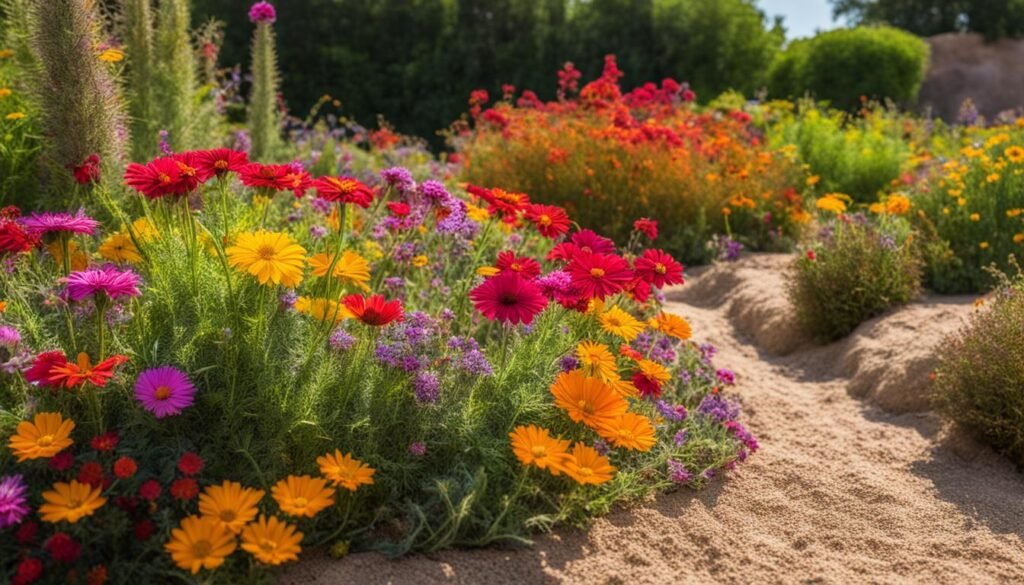
Other popular options for drought-tolerant flowers include blanket flower and blue fescue. These plants are hardy and can tolerate a wide range of growing conditions, including heat and drought. By choosing these drought-resistant plants, you can create a vibrant and water-efficient garden that thrives even in challenging climates.
Not only do drought-tolerant flowers add visual appeal to your garden, but they also serve as valuable sources of food and habitat for pollinators like bees and butterflies. By attracting these important pollinators, these plants contribute to the overall health and biodiversity of your garden ecosystem.
Drought-Tolerant Ground Covers
When it comes to landscaping in arid regions or areas with low water availability, choosing the right ground cover is essential. Drought-tolerant ground covers not only provide excellent coverage but also require minimal maintenance, making them ideal for creating water-efficient and low-maintenance landscapes.
Native plant species like bugleweed, catmint, cranesbill geranium, and hen and chicks are excellent choices for dry climates. These ground covers are specifically adapted to withstand drought conditions and thrive in arid landscapes. They have the ability to spread quickly, filling in gaps and preventing soil erosion on slopes.
By selecting drought-tolerant ground covers for your garden, you can enjoy the benefits of a visually appealing landscape that requires less water and maintenance. These low-growing plants create a beautiful carpet-like effect while conserving water in dry climates. With their ability to withstand challenging conditions, they are truly the perfect choice for creating a low maintenance garden in dry regions.
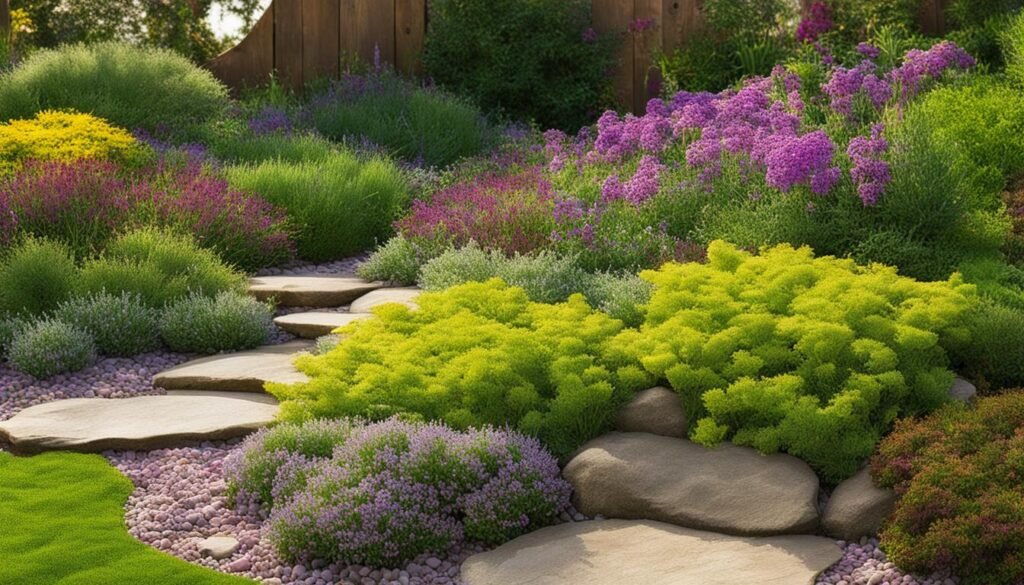
Benefits of Drought-Tolerant Ground Covers:
- Conserves water in dry climates and areas with low water availability.
- Requires minimal maintenance, reducing the need for frequent watering, mowing, and pruning.
- Prevents soil erosion on slopes by providing excellent ground coverage.
- Creates a visually appealing landscape with a carpet-like effect.
- Includes native plant species that are well-adapted to dry conditions.
Drought-tolerant ground covers are the perfect choice for homeowners looking to create a water-efficient and low-maintenance garden in dry climates. With their ability to thrive in arid landscapes and their visually appealing qualities, these plants are the ideal solution for arid landscaping and dryland gardening projects.
Drought-Tolerant Shrubs
Drought-tolerant shrubs are a great addition to any garden as they require less water and care compared to traditional shrubs. These shrubs can thrive in dry climates and poor soil conditions, making them perfect for low maintenance landscaping and water-efficient landscaping. By incorporating drought-tolerant shrubs into your landscape, you can create an attractive and sustainable garden that conserves water.
Some popular drought-tolerant shrubs include:
- Lavender
- Russian sage
- Butterfly bush
These shrubs are not only adaptable to drought but also attract pollinators with their vibrant flowers. Lavender, with its aromatic fragrance and beautiful purple flowers, adds a touch of elegance to any garden. Russian sage, with its silvery foliage and tall flower spikes, provides a stunning focal point. The butterfly bush, as the name suggests, is a magnet for butterflies and hummingbirds with its colorful blooms.
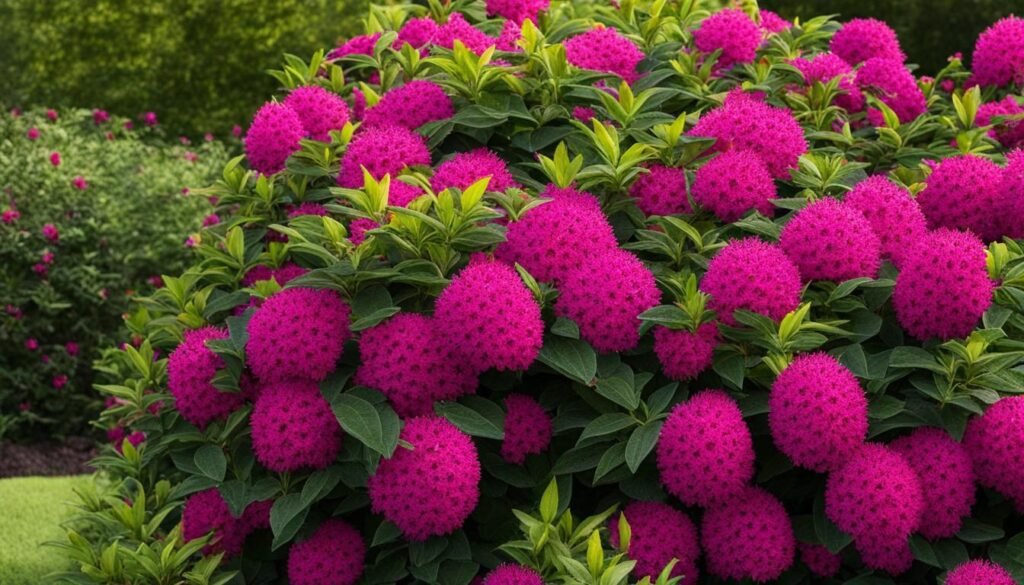
Incorporating drought-tolerant shrubs into your landscape not only reduces the need for frequent watering but also enhances the overall beauty of your garden. Whether you’re practicing xeriscaping, creating a water-efficient garden, or looking for native plants for dry conditions, these shrubs are an excellent choice. With their ability to withstand drought and attract pollinators, they create an inviting and low-maintenance environment. So, why wait? Start transforming your garden with drought-tolerant shrubs today!
Drought-Tolerant Vines
Drought-tolerant vines are a beautiful addition to any garden, providing vertical interest and lushness while conserving water. These vines are a great choice for creating stunning landscapes that cover walls, trellises, and fences. Two popular options for drought-tolerant vines are Lantana and trumpet vine.
Lantana is a versatile vine that thrives in dry climates, making it perfect for water-efficient gardening in areas like California. It features vibrant flowers that attract butterflies and hummingbirds, adding color and life to your garden. Lantana is known for its ability to tolerate drought conditions, making it an ideal choice for ca drought tolerant landscaping.
Trumpet vine is another excellent option for water-wise gardening. It is a native plant species that can withstand dry climates and low water availability. The vine produces stunning trumpet-shaped flowers in vibrant colors, attracting pollinators and adding visual appeal to your garden. Trumpet vine is a great choice for creating a visually stunning and drought-tolerant landscape.

By incorporating drought-tolerant vines like Lantana and trumpet vine into your garden, you can create a visually appealing and water-wise landscape. These vines not only add beauty but also contribute to water-efficient gardening practices. Whether you want to cover walls or enhance trellises and fences, drought-tolerant vines are the perfect choice for creating a vibrant and sustainable garden.
Drought-Tolerant Trees
When it comes to creating a drought-tolerant front yard in Southern California or designing a Southern California drought-tolerant landscape, incorporating drought-tolerant trees is a smart choice. These trees not only provide shade and add visual interest to your garden but also help to reduce water evaporation from the soil. They are well-suited to the arid conditions of the region and require less water compared to traditional tree species.
Some popular drought-tolerant trees that thrive in Southern California’s climate include mesquite, olive, and Texas ebony. These trees have adapted to arid regions and are capable of withstanding minimal water availability. Planting drought-tolerant trees in your garden can significantly contribute to a low maintenance landscaping approach, as these trees require minimal care once established.
By incorporating drought-tolerant trees into your landscape, you can create a sustainable and low-maintenance garden that thrives even in water-restricted areas. These trees will not only enhance the beauty of your outdoor space but also contribute to water-efficient gardening practices.
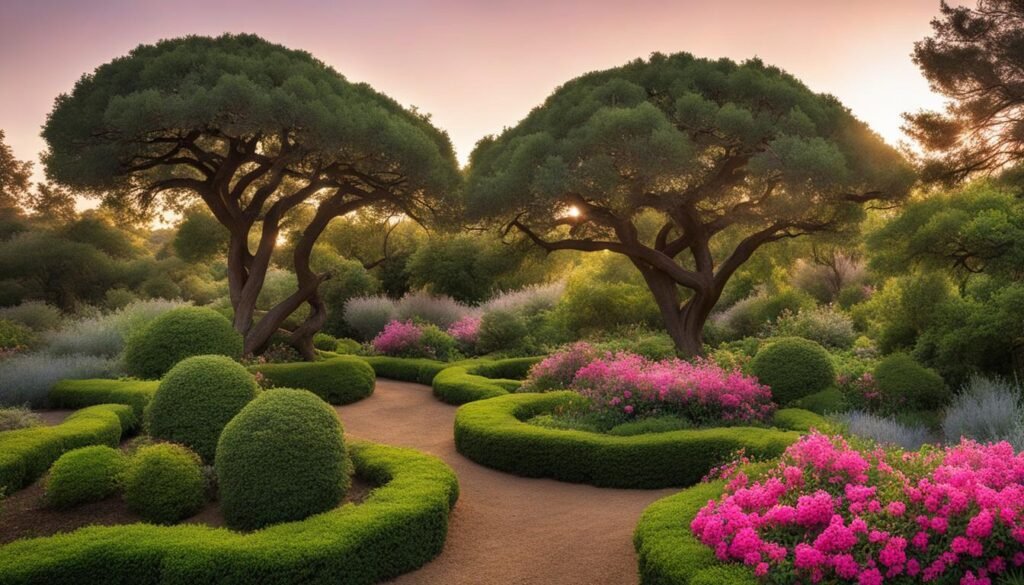
Benefits of Drought-Tolerant Trees:
- Provide shade and reduce water evaporation from the soil
- Add visual interest to your garden
- Require less water compared to traditional tree species
- Well-adapted to arid regions and can withstand minimal water availability
- Contribute to low maintenance landscaping
- Create a sustainable and water-efficient garden
Drought-Tolerant Succulents
Succulents are a fantastic choice for water-efficient gardens in dry and arid regions. These plants have adapted to thrive in harsh conditions by storing water in their fleshy leaves, enabling them to withstand drought periods. With their unique ability to conserve moisture, succulents are ideal for creating low-maintenance landscapes.
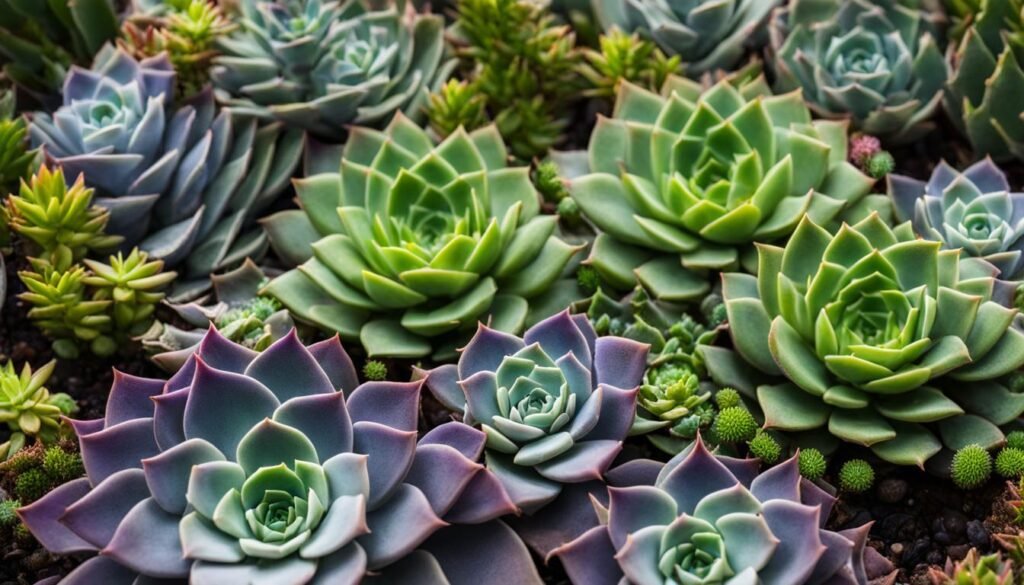
There are several popular drought-tolerant succulents that you can incorporate into your garden. Aloe vera, with its spiky leaves and healing properties, is a versatile choice that can be grown both indoors and outdoors. Agave, known for its striking architectural appearance, adds visual interest to any landscape. Sedum, with its variety of shapes, sizes, and colors, offers endless possibilities for creative arrangements.
Whether you’re designing a succulent garden, rock garden, or adding accents to existing landscaping, these resilient plants will thrive in dry regions. Their low water requirements and adaptability make them excellent choices for arid landscaping and climate adaptive vegetation.
By incorporating drought-tolerant succulents into your garden, you not only create a unique and visually appealing landscape, but also reduce water usage and maintenance efforts. These hardy plants are sure to be a stunning addition to any water-wise garden.
Conclusion
Creating a water-efficient and drought-tolerant garden is not only practical but also environmentally friendly. By selecting the right mix of drought-tolerant plants, you can create a beautiful and sustainable landscape that requires less water and maintenance.
Whether you are gardening in California or any other dry region, there are plenty of options to choose from, including flowers, ground covers, shrubs, vines, trees, and succulents. By embracing drought-tolerant plants, you can conserve water, save money on your water bill, and create a garden that thrives even in challenging conditions.
A low water garden not only helps in water conservation but also contributes to the overall aesthetics of your landscape. With water-efficient landscaping techniques, you can create a visually stunning garden that is also sustainable. Incorporating drought-tolerant plants and implementing landscaping strategies ideal for dry regions, you can achieve a thriving and low-maintenance garden without compromising on beauty or function.
So whether you’re looking to revamp your current garden or starting from scratch, consider the benefits of low water gardens and water-efficient landscaping. With the right choices and techniques, you can create a vibrant and eco-friendly landscape that not only saves water but also stands as a testament to your commitment to sustainable living.
FAQ
What are some popular drought-tolerant flowers for my garden?
Some popular drought-tolerant flowers include asters, beardtongue, black-eyed Susan, blanket flower, and blue fescue.
Which ground covers are drought-tolerant and low maintenance?
Some drought-tolerant ground covers include bugleweed, catmint, cranesbill geranium, and hen and chicks.
What are some popular drought-tolerant shrubs?
Lavender, Russian sage, and butterfly bush are popular choices for drought-tolerant shrubs.
Which vines can withstand dry climates and require less water?
Lantana and trumpet vine are popular choices for drought-tolerant vines.
What are some drought-tolerant trees for a sustainable landscape?
Mesquite, olive, and Texas ebony are popular choices for drought-tolerant trees.
Which succulents are drought-tolerant and suitable for water-efficient gardens?
Aloe vera, agave, and sedum are popular choices for drought-tolerant succulents.







